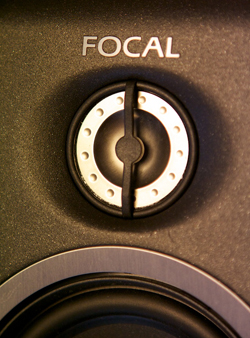
Settings and Features
Let’s start with some good points: the power on/off switch and the volume control (-66 dB to 0 dB) are conveniently placed on the front panel, where you also have power and clip LEDs.
On the rear panel you’ll find a balanced XLR input (10 kOhm), an unbalanced RCA input (47 kOhm) and the power socket.
You can set the input level to +4dBu, -10dBV or 0dB.
Adjusting the speakers’ response is very simple with two filters: a low shelve (0 Hz – 450 Hz) with -/+2 dB amplification/attenuation and a high shelve (4.5 kHz -20 kHz).
The frequency response stated by the manufacturer is 60 Hz to 28 kHz (-/+3 dB). Two integrated amps of 25 watts each (one per transducer) deliver 97 dB as maximum SPL level (@ 1 m).
Unlike the CMS 50 and CMS 65, the CMS 40 has no real low-cut filter so you’ll have to set the cutoff directly on the subwoofer (the CMS Sub for instance!) at approx. 60 Hz.
However, we tested the monitors without a subwoofer since we had already tested it with the CMS 50 earlier this year.
Let’s listen to the sound…
Sound and Mix
We compared the CMS 40 with three other monitor speakers: M-Audio DMS 1, Tannoy Reveal 601A and ADAM A3X. We listened to well-known songs and used the speakers in several home-studio situations (mixdown, recording, etc.).
From the very first notes we were pleasantly surprised by the amazingly powerful and well-balanced sound coming from these small boxes.
The low-end is far from ridiculous and we even had to check several times that the sound was actually coming from the CMS 40, rather than from a bigger monitor speaker in the studio. The small Focals show no mercy when mixing down thanks to some very present and detailed mids.
Unlike many small-sized monitor speakers, the small Focals have no hollow response, which makes them seem a bit dull in the beginning. Actually, the sound is very well balanced and the middles are not masked by the high frequencies.
The low-frequency response is much more limited than on 8” speakers, but it goes down deep enough and stays clear all the time. We noticed no masking effects (which usually make a mix sound blurry and unintelligible).
The CMS 40 revealed some details, especially on vocals, we couldn’t notice with other speakers. Very good! Moreover, our final mixes with the CMS 40 translated very nice and well-balanced into other sound systems, with no ugly surprises.
You’ll probably have the feeling that the frequency response of these speakers is narrower — they certainly have less low-end and high-end than other monitors we’ve reviewed.
But behind this feeling, there is the fact that the CMS 40 is often straighter: don’t be taken in by the hollow sound of other models!
If you listen carefully to speakers that seem to sound better, you’ll notice that some details are missing in the mid frequency range.
Generally speaking, the CMS 40 have a better dynamic response than other models we’ve reviewed: certain signals really cut through the mix, providing a more authentic depth feel.
Another good thing is that the sweet spot of this model is pretty wide so you can move around in your room without too many surprises. What’s more, the speakers seem to not be affected by the (sometimes bad) room acoustics.

